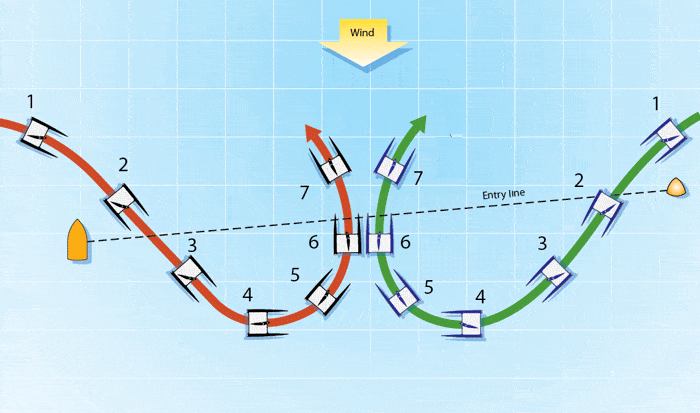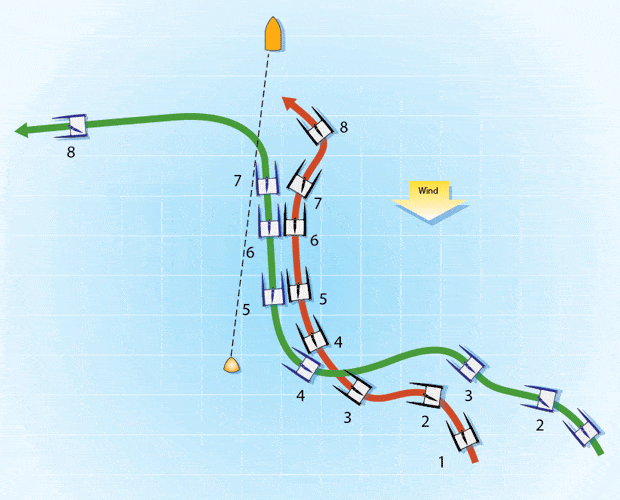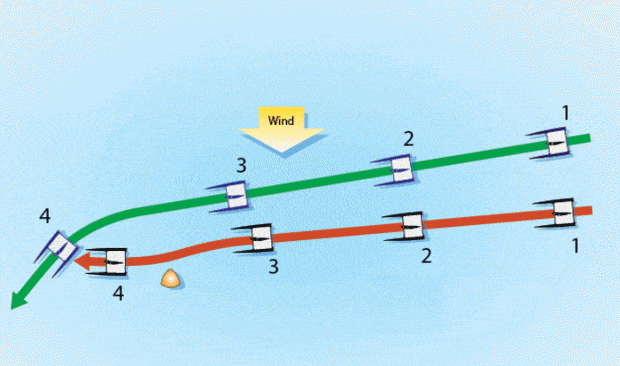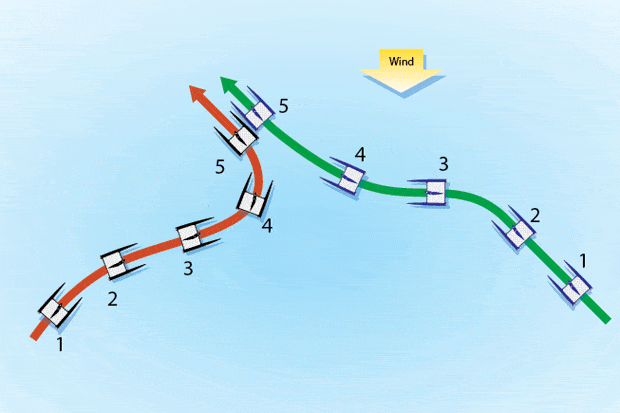
The Dial Up
The America’s Cup has a lot of traditions, many of which will be discarded this summer. This regatta has its own set of racing rules, and an elaborate electronic umpiring system. The overlying goal is to make sailing a more attractive spectator sport and therefore appeal to a larger audience. For this to happen, the rules must be simplified. We use the existing rules as a starting point, scrutinizing each of them. If one wasn’t necessary, it was eliminated. If it was complicated, it was rewritten. If a rule didn’t work well with cats going 40 knots, or with an electronic umpire system, it was modified.
Integral with the new rules is the electronic umpire system, which can track the position of the race yachts and marks to 2 centimeters (0.8 inch) accuracy, updated 10 times a second. The umpires can observe the positions of the yachts in real time from a bird’s eye view. They have all the pertinent data of each yacht: speed over ground, course over ground, true-wind angle, and true windspeed (TWS) at each turning mark. They have the percentage polar performance of each boat, as well as the leg number and penalty status. The course limits, marks, and their respective zones are available, too. The umpires can freeze frame, rewind, and fast-forward the action back to real time, which gives them the facts right at their fingertips so they can swiftly make the right call.
When competitors protest on the water they use the electronic umpiring system by pressing a button on their AC72. A window pops up on the umpire’s computer screen showing each yacht’s position, frozen 5 seconds before the button was pushed. The umpire makes a decision after reviewing the incident and signals his call electronically to the boat. If there is no penalty, this message is sent to both competitors. If there is a penalty, this message is relayed to the yachts, illuminating a blue signal light on the penalized yacht. When the penalty is issued, a penalty line appears behind the penalized boat on the umpire’s computer monitor. Once the penalized yacht gets behind the penalty line, the umpire clears the penalty, and the blue light goes off.
With new rules and new systems, there will be new moves, and some old faithful ones as well, but either way it should be an exciting summer. Let’s break down scenarios we’ll likely see.
The Dial Up
To prevent Dial Ups, the entry line is tilted so the port-entry boat gets across the starboard-entry boat. If the wind shifts, or if the port-entry boat is late entering and cannot cross, it’s in a world of hurt. At Position 1, both boats are allowed to enter 2 minutes before the start. Red is slightly too far upwind when it enters. At positions 2 and 3, Red, on port tack, realizes it cannot cross Green, which is on starboard tack. At Positions 4 and 5, Red heads up to pass astern of Green, but Green heads up as well. At this point, Red, because it is a port-tack give-way boat, must keep clear of Green. Green can alter its course, but is restricted by Rule 16.1 of the Racing Rules of Sailing and must therefore give Red room to keep clear.
At Position 6, both boats are head-to-wind. Because of the AC Racing Rules of Sailing’s Rule 6, the last point of certainty is that Green was on starboard tack and Red on port tack, so Red must continue to keep clear of Green. Red’s only option is to tack to starboard, which puts them in a bad position. If Red bears away on starboard tack, it will cross the starting line on port tack as an easy target. Red’s only other option is to tack to port, bear off, and jibe to approach the starting line. With a 2-minute prestart, however, it’s extremely difficult to complete all these maneuvers in time, which makes the Dial Up a more powerful weapon in the AC72 than it was in monohulls.
_Click here for the Racing Rules of Sailing America’s Cup Edition (RRSAC)_

The Hook
With the start and the first leg of the America’s Cup course being a reach, the Hook will likely be the preferred starting move. Where we used to see 12-Metres and ACC boats circling in the past, we will instead see the AC72s setting up back from the line and then using violent dips to try to “hook” its opponent. Each boat is trying to get between its opponent and the starting line so it can control the weather boat and hold it up until it’s time to peel off and go for the start. Dip too deep and you’ll be unable to fetch the starting pin. If you don’t dip enough, you leave the door open for the opponent to pull off the exact same move.
At Position 1, Red and Green approach the line on starboard tack. At Position 2, Green bears off to try to get a leeward overlap on Red. Red counters the move by dipping as well, and Green gives up.
At Position 3, Green tries again to set the hook. This time Green doesn’t want to get below the layline for the starting pin so she chooses not to dip, in order to defend her position. At Position 4, Green dives below Red and gets the hook. As the windward boat, Red must keep clear of Green, and Green must give Red room to keep clear under Rule 16.1. In Positions 5 and 6, Green holds Red up and away from the starting line. In a perfectly executed hook at Position 7, Red must tack to port to keep clear, at which point Green bears away, starts, and heads full throttle down the reach. By the time Red finishes her down-speed tack back to starboard, Green is halfway to Mark 1.
_Click here for the Racing Rules of Sailing America’s Cup Edition (RRSAC)_

The Roll
We will have a drag race on our hands if the two boats get off the line fast and clean. If the leeward boat can poke out, it will round the first mark ahead and have clean air. If the windward boat gets the edge and passes to windward, the goal is to block the leeward boat’s wind. What’s unusual with the AC72s is that the disturbed airflow streams behind. Once on foils, the AC72 can exceed 30 knots in as little as 15 knots of wind. This puts its “bad air” at an angle of less than 30 degrees to its stern. This means the windward boat must be almost clear ahead of the leeward boat in able to really gas them. The closer the windward boat is to the leeward boat (laterally) the less forward it has to be to gas its opponent, and the more damaging its bad air is. As a windward boat, Green must be careful not to get too close because it is required to keep clear of Red. As the boats approach the first mark, they close gauge. This is where the windward boat usually makes its final effort to roll the leeward boat, and the leeward boat makes a last-ditch effort to luff the windward boat. If the umpires determine that Red is unable to luff Green, they will signal “no penalty.” If they decide that Red had to curtail its luff, Green picks up a penalty for breaking RRSAC 11.
_Click here for the Racing Rules of Sailing America’s Cup Edition (RRSAC)_

The Dial Down
We will likely find that one boat is faster downwind and the other is faster upwind. If this is the case, then we will see the faster downwind boat attempting aggressive moves. The best way to do this in a multihull is to force the other boat to tack. The standard match-racing move to do this is the Dial Down. This move can be a little scary in monohulls, but in AC72s it’s absolutely frightening. Nonetheless, the teams have practiced this move and have it in their arsenal.
At Position 1 both boats are sailing upwind: Green on starboard tack and Red on port tack. At Position 2, Red starts to bear away in order to duck Green. In response, Green can bear away at Position 3 to prevent Red from passing astern, so long as Green does not break RRSAC 16.1 or 16.2. At Position 4, rather than risk a dramatic bear away, which can be risky in an AC72, Red chooses to head up in order to cross Green, but Green heads up as well to prevent Red from crossing. As right-of-way boat, Green is entitled to do so, as long as it complies with RRSAC 16.1 and gives Red room to keep clear. At Position 5, Red must tack to keep clear, and Green now has Red right where they want them—pinned and gasping for clean air.
_Click here for the Racing Rules of Sailing America’s Cup Edition (RRSAC)_









